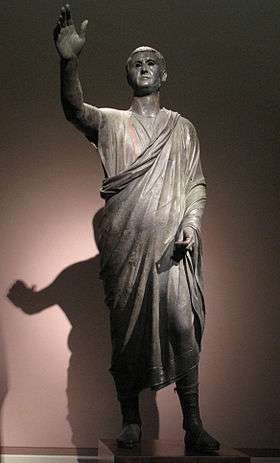The Orator
For the New Zealand film, see The Orator (film).
 | |
| Year | c. 100 BCE |
|---|---|
| Medium | bronze |
| Dimensions | 179 cm (70 in) |
| Location | National Archaeological Museum, Florence |
Aule Metele, Latin: Aulus Metellus; also known as The Orator, Italian: L'Arringatore, is a bronze sculpture 179 cm high.[1] It is a Romano-Etruscan work from the late second century or early first century BCE in the Roman style and depicts an Etruscan man, Aule Metele, wearing a short Roman toga and footwear. His right arm is raised to indicate that he is an orator addressing the public.[2]
The retrograde inscription is in the Etruscan alphabet reads: : “auleśi meteliś ve[luś] vesial clenśi / cen flereś tece sanśl tenine / tu θineś χisvlicś” (“To (or from) Auli Meteli, the son of Vel and Vesi, Tenine (?) set up this statue as a votive offering to Sans, by deliberation of the people”).[3][4]
Gallery
 Detail of inscription
Detail of inscription- Detail of inscription
- Detail of head
- Detail of left hand
See also
References
- ↑ Larissa Bonfante (1986). Etruscan Life and Afterlife: A Handbook of Etruscan Studies. Wayne State University Press. pp. 139–. ISBN 0-8143-1813-4.
- ↑ Horst Woldemar Janson; Anthony F. Janson (2004). History of Art: The Western Tradition. Prentice Hall Professional. pp. 190–. ISBN 978-0-13-182895-7.
- ↑ TLE 651; CIE 4196
- ↑ Koen Wylin (2000). Il verbo etrusco: ricerca morfosintattica delle forme usate in funzione verbale. L'ERMA di BRETSCHNEIDER. pp. 112–. ISBN 978-88-8265-084-1.
| Wikimedia Commons has media related to Arringatore. |
This article is issued from Wikipedia - version of the 10/13/2016. The text is available under the Creative Commons Attribution/Share Alike but additional terms may apply for the media files.